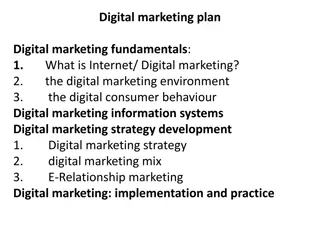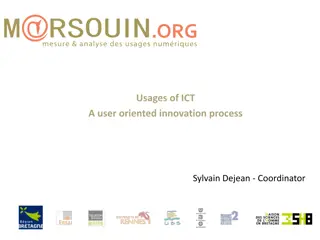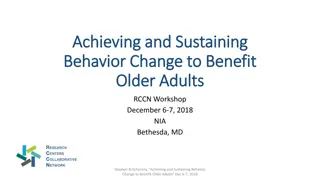Revolutionizing Social and Behavior Change with Digital Health Innovations
Embracing digital technologies for social and behavior change opens new avenues to reach people effectively. High Impact Practices (HIPs) in family planning leverage digital health tools to address systemic barriers, enhance service delivery, and influence positive behaviors and social norms. The use of digital technologies like mobile phones and computers can empower individuals to adopt healthy sexual and reproductive behaviors, offering convenient access to information. The partnership and expertise of experts in the field ensure the success of HIP implementation for impactful change.
Download Presentation

Please find below an Image/Link to download the presentation.
The content on the website is provided AS IS for your information and personal use only. It may not be sold, licensed, or shared on other websites without obtaining consent from the author.If you encounter any issues during the download, it is possible that the publisher has removed the file from their server.
You are allowed to download the files provided on this website for personal or commercial use, subject to the condition that they are used lawfully. All files are the property of their respective owners.
The content on the website is provided AS IS for your information and personal use only. It may not be sold, licensed, or shared on other websites without obtaining consent from the author.
E N D
Presentation Transcript
Digital Health for Social and Behavior Change New technologies, new ways to reach people. Digital Health for Social and Behavior Change
Overview What is a HIP? HIP Categories Partnership 1. Introduction to the High Impact Practices (HIPs) PART PART Background Theory of Change What challenges can this HIP help address? Evidence of Impact 2. Digital Health for Social and Behavior Change 3. Extra Slides Implementation Tips Tools & Resources 2 Digital Health for Social and Behavior Change
High Impact Practices in Family Planning (HIPs) are Vetted by experts against specific criteria Evidence-based family planning practices Documented in an easy-to-use format 3 Digital Health for Social and Behavior Change
HIPs address the full spectrum of FP programming Enabling Environment Social and Behavioral Change Service Delivery PART Address systemic barriers that affect an individual s ability to access family planning information & services. 8 briefs Improve the availability, accessibility, acceptability, and quality of family planning services. 8 briefs Influence knowledge, beliefs, behaviors, and social norms associated with family planning. 7 briefs Enhancements Approaches used in conjunction with HIPs to maximize the impact of HIP implementation or increase the reach. 4 briefs 4 Digital Health for Social and Behavior Change
HIP Partnership The Technical Advisory Group (TAG) is made up of 25 experts in family planning, including representatives from the co-sponsors. The Co-sponsors include the following organizations: 5 Digital Health for Social and Behavior Change
High Impact Practice Use digital technologies to support, maintain, and adopt healthy sexual and reproductive behaviors. 6 Digital Health for Social and Behavior Change
Background Using digital technologies such as mobile phones, computers, or tablets to convey information and messages as part of social and behavior change (SBC) strategy may contribute to healthy sexual and reproductive behavior. Making information available through digital applications may also reduce the time and cost related to seeking or receiving information through more traditional sources, such as print or interpersonal communication. 7 Digital Health for Social and Behavior Change
Theory of Change BACKGROUND 8 Digital Health for Social and Behavior Change
What challenges can this HIP help address? Digital technologies for clients contribute to improving sexual and reproductive health knowledge; influencing attitudes, beliefs, and expectations; and increasing self-efficacy in support of healthy reproductive behaviors. Digital technologies for clients may contribute to shifting norms and increasing social support for healthy reproductive behaviors. Digital technologies may offer more options to reach young people. 9 Digital Health for Social and Behavior Change
Evidence of Impact Example: In Nigeria, participants opted to receive a series of 17 prerecorded interactive voice response (IVR) calls daily or twice a week, which included a drama segment followed by an interactive component where participants could choose to listen to additional information and answer call-related quizzes. This led to: An increase in modern contraceptive use among the intervention group. Contraceptive use in the control group remained nearly the same. 10 Digital Health for Social and Behavior Change
Implementation Tips Engage with end-users early in the design process to decide on the most appropriate type of technology to use and how best to use it. It is generally recommended to use technologies with which end-users are already familiar, rather than introducing new types of technologies that require a significant learning curve. For example, if the target audience owns smartphones, tablets, or computers, then the intervention may focus on building a website or using social media sites like Facebook or Twitter. 11 Digital Health for Social and Behavior Change
Implementation Tips Determine end-user preferences for format (e.g., text or audio), language, and frequency and dose of messaging. Different formats have different advantages and appeal to different target audiences. When pushing content directly to individuals, programs must ask potential end-users about the frequency and timing of messages. 12 Digital Health for Social and Behavior Change
Thank You Continue to the extra slides or access the HIP brief for more information. 13 Digital Health for Social and Behavior Change
Extra Slides Implementation Tips Priority Research Questions Tools & Resources 14 Digital Health for Social and Behavior Change
Implementation Tips Consider how best to protect individual privacy. While mobile phones can increase an individual s sense of privacy for example, offering access to contraceptive information without having to visit a clinic or provider they may also expose individuals to real or perceived risks that must be considered during the design of any digital health intervention. 15 Digital Health for Social and Behavior Change
Implementation Tips Understand end-users literacy levels and comfort with text- based content. IVR, hotlines, or image-based content such as graphic stories may be more appropriate for low-literacy individuals than SMS or other text-based content. 16 Digital Health for Social and Behavior Change
Implementation Tips Test content with potential end-users for comprehension and appropriateness and test the platform for usability. It is very important to ensure that end-users understand and interpret digital content in the intended ways. 17 Digital Health for Social and Behavior Change
Implementation Tips Budget accurately, including initial and recurring costs, and project costs at scale. Though actual costs vary substantially across countries and contexts, cost categories that must be budgeted can include: research, technology development (e.g., software, programming, server), hardware, data (SMS, airtime, data time), staff, and promotion. 18 Digital Health for Social and Behavior Change
Implementation Tips Weigh the desire to reach end-users, including those most economically marginalized, against budget requirements for implementing digital health applications over the long term. For programs focused on reaching the most vulnerable populations, it is likely that content will need to remain free or heavily subsidized for the user, and thus other innovative financial models must continue to be explored. 19 Digital Health for Social and Behavior Change
Implementation Tips Use digital health applications built-in feature to support robust monitoring and evaluation. If designed well, evaluations of digital health interventions can determine their effectiveness, including value for money, as well as impact, though these evaluations may or may not be conducted using only digital data collection methodologies. 20 Digital Health for Social and Behavior Change
Priority Research Questions Does the use of digital applications (e.g., SMS, IVR, social media) positively impact contraceptive behavior change and social norms? Which platforms (e.g., SMS, IVR, social media) are most effective? What is the cost, reach, and potential for sustainability of using digital health applications in different contexts? 21 Digital Health for Social and Behavior Change
Tools & Resources mHealth for Behavior Change Communication Brief: Why mHealth Messaging? 22 Digital Health for Social and Behavior Change
fphighimpactpractices.org Digital Health for Social and Behavior Change























